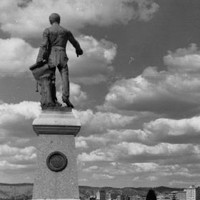Place
ContributeMontefiore Hill is a small rise north of the River Torrens to North Adelaide. The elevated position enables views of parts of the city, suburbs and Mount Lofty Ranges.
The hill was named for Jacob Montefiore by the committee of prominent colonists who named all of the main streets and squares of Adelaide on 23 May 1837. The location also became known as Light’s Vision: a statue of Colonel William Light (1786–1839) points towards the city that he sited and surveyed.
Jacob Montefiore
Jacob Montefiore (1801–95) was the eldest son of Eliezer Montefiore, merchant and sugar planter of Barbados and London, and Judith (née Barrow). Jacob lived and was educated in London. He too became involved with the colonial produce trade and went on to develop a keen interest in the Australian colonies. Jacob Montefiore invested in the Swan River settlement (Perth, Western Australia) in 1829 and he shared real estate business interests in New South Wales with his youngest brother, Joseph Barrow Montefiore.
Montefiore and South Australia
Jacob Montefiore became a member of the South Australian Colonisation Association which was formed to settle South Australia on the Wakefield system. In May 1835 he was appointed one of the 11 South Australian Colonisation Commissioners responsible for establishing the colony. He held this position until 1839.
With Lieutenant-Colonel George Palmer jnr (1799–1883), Montefiore assisted Colonel Light in preparing the ships Rapid and Cygnet for their journey to South Australia in 1836. Montefiore and Palmer trialled a new code that required an emigrant ship carrying more than 100 passengers to have a medical practitioner on board and to observe a minimum deck height. These reforms, first adopted by the South Australian Colonisation Commissioners, led to a greatly decreased mortality rate. In 1839 the code was adopted for all British colonial emigrant ships.
Montefiore visited South Australia in 1843 and was received by Governor George Grey. He visited again in 1854 by when his brother was again a successful businessman, running JB Montefiore & Co. in Adelaide. Jacob Montefiore promoted South Australia throughout the rest of his life, taking care to highlight the work of his friend Colonel Light. Montefiore and Palmer were two of the four friends of Light who donated a large silver bowl to the Adelaide City Council in 1859 to be used for toasting his memory (Bulbeck, p263). In 1885 he presented a portrait of himself, painted by the artist Barnett Samuel Marks, to the National (later Art) Gallery of South Australia.
In 1886 Jacob Montefiore was appointed as South Australia’s honorary commissioner at the Colonial and Indian Exhibition in London. He died in London in 1895.
Light’s Vision
Montefiore Hill was developed as a lookout as part of South Australia’s centenary celebrations in 1936. The project involved levelling the top of the hill, creating a garden and constructing a balustrade. The lookout honoured the pioneers, but early in 1938 Sir Henry Newland (1873–1969), an Adelaide surgeon and president of the Pioneers Association of South Australia, suggested redesigning and expanding the area, shifting Colonel Light’s statue from Victoria Square to there and renaming the precinct ‘Light’s Vision’ in time for the centenary of Light’s death in October 1939.
The association’s grand plan was rejected by the Adelaide City Council, but it accepted the proposed name and the relocating of the statue which in May 1938 was moved to Montefiore Hill where it became a focal point of the balustraded garden lookout. Until 2013 Light stood with his right index finger pointing to the city below, but the redevelopment of Adelaide Oval in 2012–13 has obscured the view of the city, causing some controversy and has lessening the impact of a visit to Light’s Vision.
Media
Add mediaImages

Image courtesy of the State Library of South Australia, SLSA: B 1121, http://images.slsa.sa.gov.au/mpcimg/01250/B1121.htm, Public Domain

Image courtesy of the State Library of South Australia, SLSA: B 21078, http://images.slsa.sa.gov.au/mpcimg/21250/B21078.htm, Public Domain.

Image courtesy of the State Library of South Australia SLSA: B 45558/34, http://images.slsa.sa.gov.au/mpcimg/45750/B45558_34.htm, Public Domain

Image courtesy of the State Library of South Australia, SLSA: B 71816, http://images.slsa.sa.gov.au/mpcimg/72000/B71816.htm, Public Domain

Image courtesy of the State Library of South Australia, SLSA: B23767, http://collections.slsa.sa.gov.au/resource/B+23767, Public Domain

Gift of Mr. James Montefiore 1885, Art Gallery of South Australia, Adelaide. Not to be reproduced without permission.

Image courtesy of the State Library of South Australia, SLSA: B11232, http://collections.slsa.sa.gov.au/resource/B+11232, Public Domain





Comments
CommentAdd new comment
Good post, thank you!
Hi David,
Jacob Montefiore only ever visited South Australia, he did not live here. His brother, Joseph, did move to Adelaide when he set up business here, but we'd need to do a bit more research to find out where he lived.
Where was the Montefiore residence and for how long, please.
Thanks Jude, that's great to know.
While Joseph was active in South Australia and lived nearby, surviving records relating to the committee of prominent colonists who named the streets and squares of Adelaide, and later reports, indicate that Montefiore Hill was named after his brother Jacob.
I'll have to check with the author to see what her source for that was Tessa, sounds like a good argument, but I'm afraid I'm not familiar with that history myself.
Re name of Montefiore Hill: since Joseph Barrow Montefiore had his house there (surviving in altered form), might not Montefiore Hill be named after him rather than afar his brother Jacob?